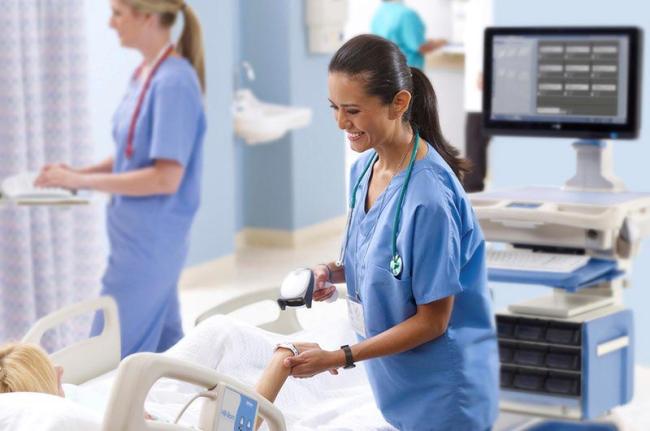How to Select the Best Medical Cart for Your Healthcare Facility
Although the general purpose of medical carts is to transport medication and supplies, each cart needs to be customized to serve the needs of clinicians in a particular department. For example, a cart for pediatrics may have slight variations in design and functionality from a general procedure cart. Here we will look at different use models for some of the more common medical carts.
Emergency Response Cart
An emergency response cart, or crash cart, is stocked with lifesaving equipment so that the critical response team has everything they need right there in one spot. Important accessories include provisions for IV poles, a defibrillator, oxygen tanks, a CPR board, a sharps container, and medications. These carts must always be stocked and ready to respond. This cart can be wheeled to the location of the emergency. So it is important that it be easy to maneuver and lightweight, yet robust enough to hold up to the rigors of a code response.
General Procedure Cart
This is the most common type of medical cart. It is used for conducting a variety of medical procedures and patient rounds. It can be used in a variety of situations so should be durable yet comfortable for staff to use so that it doesn’t cause fatigue. These carts should be flexible, allowing you to store and organize supplies in the way that works best for a particular workflow. A general procedure cart therefore typically has a full range of accessories such as polymer side bins, a glove box holder, a waste basket, overbridge storage accessories, and accessory rails, to provide a mobile storage solution for the full range of application needs.
Although the general purpose of medical carts is to transport medication and supplies, each cart needs to be customized to serve the needs of clinicians in a particular department. For example, a cart for pediatrics may have slight variations in design and functionality from a general procedure cart. Here we will look at different use models for some of the more common medical carts.
Intelligent Procedure Cart
Compared to other supply carts, intelligent procedure carts will have a computer that allows greater control over the organization and storage of supplies, and also the integration of technology that offers access to patient information directly from the cart. The most useful and power-efficient intelligent procedure carts will be powered by DC optimized batteries so that they can deliver greater efficiency than AC options on the market. Though the carts are powered, there should be no compromise on mobility or customization. These carts should still be able to move smoothly and easily and pack a full set of accessories that meet your workflow needs. For example, intelligent procedure carts should still be able to hold IV poles, polymer side bins, sharp container brackets, technology accessories and more.
Anesthesia Cart and Intelligent Anesthesia Cart
Designed to help anesthesiologists in their work, anesthesia carts provide secure and convenient single level drawer access to medications, controlled substances, and supplies. They are found in most Operating Rooms, but also in other specialized procedure rooms such as endoscopy suites, where some patients may be anesthetized. These carts are also present in non-hospital facilities such as ambulatory surgery centers. The cart should feature chart holders, slide-out surfaces, and IV poles, and should be made of antimicrobial materials that keep the risk of infection to a minimum. Also important for anesthesia carts are medication label dispensers, overbridge storage accessories, and accessory rails that allow you to customize the cart for the specific needs of each environment. These carts can be made intelligent by adding a DC optimized battery and all-in-one computer monitor, giving staff access to patient information directly from the cart.
Pediatric Code Response Cart
A pediatric code response cart is designed to cater to emergency needs in general pediatric departments. This may be very similar to another Emergency Response Cart, but tailored to store a different set of supplies appropriate for children. There is often more color-coding and visual identification than on a standard red Emergency Cart, so that the proper medications and supplies can be found quickly and easily. The cart should still include secure cabinets, drawers, provisions for a defibrillator, and IV poles designed to serve the needs of pediatric patients and the relevant clinician workflows.
Isolation Cart
Medical isolation units are used to minimize the risk of spreading germs, pathogens, and infections. These areas require quick and convenient storage as well. Isolation carts should be made of stainless steel, microbe-resistant polymer, and feature specialized coatings that can reduce the chance of a cart becoming a fomite for pathogens that cause hospital-acquired infections. These carts are generally configured simply to make cleaning easier.
Compared to other supply carts, intelligent procedure carts will have a computer that allows greater control over the organization and storage of supplies, and also the integration of technology that offers access to patient information directly from the cart. The most useful and power-efficient intelligent procedure carts will be powered by DC optimized batteries so that they can deliver greater efficiency than AC options on the market. Though the carts are powered, there should be no compromise on mobility or customization. These carts should still be able to move smoothly and easily and pack a full set of accessories that meet your workflow needs. For example, intelligent procedure carts should still be able to hold IV poles, polymer side bins, sharp container brackets, technology accessories and more.



